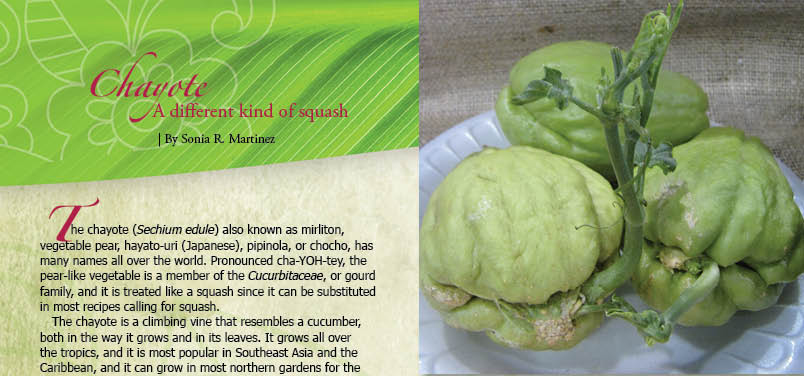
Chayote—A Different Kind of Squash

By Sonia R. Martinez
The chayote (Sechium edule) also known as mirliton, vegetable pear, hayato-uri (Japanese), pipinola, or chocho, has many names all over the world. Pronounced cha-YOH-tey, the pear-like vegetable is a member of the Cucurbitaceae, or gourd family, and it is treated like a squash since it can be substituted in most recipes calling for squash.
The chayote is a climbing vine that resembles a cucumber, both in the way it grows and in its leaves. It grows all over the tropics, and it is most popular in Southeast Asia and the Caribbean, and it can grow in most northern gardens for the summer season since it is a fast growing and producing vine.
Some varieties are smooth skinned while others feel like they are covered with Velcro™, and the color can range from green to tan to almost white. The single seed is edible after cooking and has a mild, nutty flavor.
The immature fruit needs no peeling, and yet it is advisable as it can be covered with little spines on the surface. Chayotes will keep from two to three weeks in the refrigerator. On their own, they are low in fat and calories, containing only 40 calories per 1-cup serving, making it a wonderful main ingredient or used in recipes. It can be added to stir-fry, soup, stew, or as a side dish sautéed with onions, garlic, and herbs. It teams well with tomatoes, onions, peppers, and corn for a delightful and summery succotash.
Not only are the fruits edible, the entire plant is edible. The vines are fibrous except for the tips. The last six inches can be eaten raw or cooked, same as the fruits. The vine tips are good in salad, stir-fry, stews, and soups. They are also good used as greens, cooked with onions, tomatoes, and herbs.
Mild tasting like zucchini, with a slightly citrus tang, their denser texture requires more cooking time than zucchini. The easiest way I have found to cook them is to boil them for just 10-15 minutes or so. You want them cooked, yet not too soft. Peel and cut them in thin slices. Marinate the slices in your favorite Italian salad dressing and grill them to serve as a side dish at your next cookout.
Another easy way to cook chayote is to microwave it. It stays green and crisp-tender. To microwave, cut a chayote into 1/2-inch cubes and place in a microwave dish. Add 1/4 cup water and cover; cook on high for seven to eight minutes or until tender when pierced with the tip of a small knife. Drain off excess water, add butter, and season to taste and serve, or mix with other ingredients when preparing a dish.
Tender raw chayote can be thinly sliced, julienned, or diced and added to salads, slaws, or salsas for a delicious crunch. They can also be stuffed and baked as an au-gratin. And they are delicious pickled!
Quick Chayote Refrigerator Pickles
10–12 chayote, peeled and sliced
3 large red onions, thinly sliced
5–6 Hawaiian, Habanero, or Jalapeño chile peppers
1 liter white vinegar
1 cup water
1–2 cups brown sugar, packed, or to taste
6–8 cinnamon sticks
Star anise—I used one whole package, about 2-dozen pieces
Place the vinegar, water, brown sugar, cinnamon sticks, and star anise in a pot. Bring to boil, turn heat to low, and simmer for about five minutes.
In the meantime, rinse, drain, peel, and slice the chayote and onions. Trim the tops off the chile peppers; slice and seed—or not—depends on your taste.
Pack the chayote and onion slices in clean glass jars. Pour the simmering pickle liquid to the top, and insert cinnamon sticks and star anise into the jars.
Put aside to cool. Seal tightly and refrigerate without opening for at least two days. They will last a few weeks as long as they are refrigerated.


